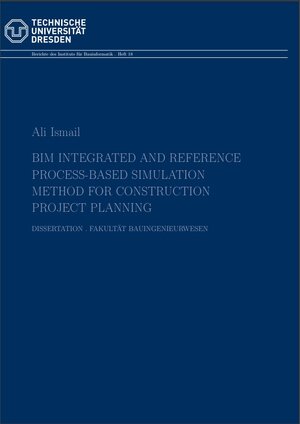
×
![Buchcover ISBN 9783867807135]()
BIM Integrated and Reference Process-based Simulation Method for Construction Project Planning
von Ali IsmailUsing simulation to support construction project planning has many advantages, which have been presented in various academic researches. Many applications have successfully demonstrated the potential of using simulation to improve the quality of construction project planning. However, the wide adoption of simulation has not been achieved in practice yet. It still has very limited use compared with other industries due to some major obstacles and challenges.
The first challenge is the complexity of construction processes and projects planning methods, which make it very difficult to develop realistic simulation models of construction processes and represent their dynamic behavior and the interaction with project resources. This led to lack of special simulation tools for construction project planning. The second challenge is the huge amount of project information that has to be integrated into the simulation model and to be maintained throughout the design, planning and construction phases. The preparation of ad-hoc simulation models and setting up different scenarios and verification of simulation results usually takes a long time. Therefore, creating reliable simulation models requires extensive resources with advanced skills.
The presented challenges prevent the wide application of simulation techniques to support and improve construction project planning and adopt it as an essential part of the construction planning workflow in practice.
The research work in this thesis addresses these challenges by developing an approach and platform for rapid development of simulation models for construction projects. The main objective of this research is to develop a BIM integrated and reference process-based simulation approach to support planning of construction projects and to enable collaboration among all actors involved in the planning and simulation process.
The first challenge has been addressed through the development of construction simulation toolkit and the Reference Process Model (RPM) method for modelling construction processes for production and logistics using Business Process Modelling and Notation (BPMN). The RPM models are easy to understood also by non-experts and they can be transformed automatically into simulation models as ready-to-use modules. They describe the workflow and logic of construction processes and include information about duration, resource requirements and other related information for different construction domains with different levels of details. The use of BPMN has many advantages. It enables the understanding of how simulation models work by project teams, including those who are not experts in simulation.
In this approach, the modelling of Reference Process Models is totally separated from the simulation core components. In this way, the simulation toolkit is generic and extendable for various construction types such as buildings, bridges and different construction domains such as structural work and indoor operations.
The presented approach supports continuous adoption of simulation models throughout the whole project life cycle. The simulation model which supports project planning in the early design phase can be continuously extended with more detailed RPMs and updated information through the planning and construction phases.
The second challenge has been addressed by supporting direct integration of Building Information Modelling (BIM) method with the simulation modelling based on the Industry Foundation Classes IFC (ISO 16739) standard, which is the most common and only ISO standard used for exchanging BIM models. As the BIM models contain the biggest part of the input information of simulation models and they can be used for effective visualization of results in the form of animated 4D BIM models. The integration between BIM and simulation enables fast and semi-automatic filtering, extraction and transformation of the necessary information from BIM models for both design and construction site models. In addition, a special top-down semi-automatic detailing method was developed in order to accelerate the process of preparing detailed project schedules, which are essential input data for the simulation models and hence reduce the time and efforts needed to create simulation models.
The developed approach has been implemented as a software prototype in the form of a modular Construction Simulation Toolkit (CST) based on the Discrete Event Simulation (DES) method and an online collaboration web portal „ProSIM“ for managing simulation models.
The collaboration portal helps to overcome the problem of huge information and make simulation models accessible for non simulation experts.
Simulation models created by CST toolkit facilitate the evaluation of design alternatives and construction methods with minimal changes in the simulation model. Both production and logistic operations can be simulated at the same time in a unified environment and take into account the shared resources and the interaction between production and logistic activities. It also takes into account the dynamic nature of construction projects and hence the changes in the construction site layout during the construction phase. The verification and validation of the proposed approach is carried out through various academic and real construction project case studies.
The first challenge is the complexity of construction processes and projects planning methods, which make it very difficult to develop realistic simulation models of construction processes and represent their dynamic behavior and the interaction with project resources. This led to lack of special simulation tools for construction project planning. The second challenge is the huge amount of project information that has to be integrated into the simulation model and to be maintained throughout the design, planning and construction phases. The preparation of ad-hoc simulation models and setting up different scenarios and verification of simulation results usually takes a long time. Therefore, creating reliable simulation models requires extensive resources with advanced skills.
The presented challenges prevent the wide application of simulation techniques to support and improve construction project planning and adopt it as an essential part of the construction planning workflow in practice.
The research work in this thesis addresses these challenges by developing an approach and platform for rapid development of simulation models for construction projects. The main objective of this research is to develop a BIM integrated and reference process-based simulation approach to support planning of construction projects and to enable collaboration among all actors involved in the planning and simulation process.
The first challenge has been addressed through the development of construction simulation toolkit and the Reference Process Model (RPM) method for modelling construction processes for production and logistics using Business Process Modelling and Notation (BPMN). The RPM models are easy to understood also by non-experts and they can be transformed automatically into simulation models as ready-to-use modules. They describe the workflow and logic of construction processes and include information about duration, resource requirements and other related information for different construction domains with different levels of details. The use of BPMN has many advantages. It enables the understanding of how simulation models work by project teams, including those who are not experts in simulation.
In this approach, the modelling of Reference Process Models is totally separated from the simulation core components. In this way, the simulation toolkit is generic and extendable for various construction types such as buildings, bridges and different construction domains such as structural work and indoor operations.
The presented approach supports continuous adoption of simulation models throughout the whole project life cycle. The simulation model which supports project planning in the early design phase can be continuously extended with more detailed RPMs and updated information through the planning and construction phases.
The second challenge has been addressed by supporting direct integration of Building Information Modelling (BIM) method with the simulation modelling based on the Industry Foundation Classes IFC (ISO 16739) standard, which is the most common and only ISO standard used for exchanging BIM models. As the BIM models contain the biggest part of the input information of simulation models and they can be used for effective visualization of results in the form of animated 4D BIM models. The integration between BIM and simulation enables fast and semi-automatic filtering, extraction and transformation of the necessary information from BIM models for both design and construction site models. In addition, a special top-down semi-automatic detailing method was developed in order to accelerate the process of preparing detailed project schedules, which are essential input data for the simulation models and hence reduce the time and efforts needed to create simulation models.
The developed approach has been implemented as a software prototype in the form of a modular Construction Simulation Toolkit (CST) based on the Discrete Event Simulation (DES) method and an online collaboration web portal „ProSIM“ for managing simulation models.
The collaboration portal helps to overcome the problem of huge information and make simulation models accessible for non simulation experts.
Simulation models created by CST toolkit facilitate the evaluation of design alternatives and construction methods with minimal changes in the simulation model. Both production and logistic operations can be simulated at the same time in a unified environment and take into account the shared resources and the interaction between production and logistic activities. It also takes into account the dynamic nature of construction projects and hence the changes in the construction site layout during the construction phase. The verification and validation of the proposed approach is carried out through various academic and real construction project case studies.


